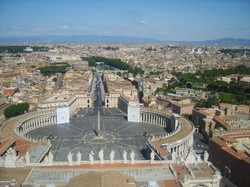One story has Jesus visiting Britain. The legend is that his uncle was Joseph of Aramathea, a relative of Mary's. This is not improbable, as the Romans used to allow relatives to collect the bodies of their executed relatives,which Joseph did in Jesus' case. But the case for a British visit is not proven.The story goes that Joseph was a tin trader [no proof of this] and therefore visited Cornwall, taking the young Jesus with him. There is no historical backing to this tale and no church traditions ever recorded it.
An intriguing tale arose in the nineteenth century. Nicolas Rohrich, a Russian traveler, was in Tibet and was discussing religion with a Buddhist abbot, what else do you do with Buddhist abbots? During the conversation Rohrich pointed out that we knew nothing of the hidden years of Jesus, only to be told that Jesus was in Tibet. The abbot produced a document detailing Jesus' time there. To cut a long story short, Novotich, another Russian, translated the document and publicized it in the West. Swami Abidananda then tried to discredit the tale and so went to the monastery of Himis [Hemis] only to find that there really was a document that said what Rohrich said that it did. He became convinced of its veracity.
The tale is that the young Issa [Jesus], aged about thirteen, joined a group of merchants heading eastwards. He went to India where he impressed the Brahmins, who tutored him in heaiing arts.However, he made enemies by opposing the caste system and idolatry. This led to his enemies plotting to kill Jesus, but he was warned and fled to Tibet, where the Buddhist monks took him in. Finally at twenty nine he returned to Israel where he was put to death by Pontius Pilate.
I have read the translation of this manuscript. Some suggest that it was influenced by Nestorian Christians, but I can find no Nestorian theology in it. It begins by saying that the soul of the world detached itself from the One to become incarnate as man in Issa. This statement has no parallel in Christian theology, though it might have some affinity to the Logos doctrine of John's Gospel. However,it does indicate that the writer considered Jesus to be more than human. The manuscript describes Jesus as the new Moses, a well-known Christian theme, but whoever wrote it shows no knowledge of the written gospels, as there is no trace of any gospel material in the manuscript, and there is no knowledge of the resurrection. There is one teaching on the value of women and one on the value of manual work, but the whole text is short on teaching. This limitation leads me to think that as Nestorian Christians are as knowledgeable on scripture as other Christians are, the manuscript did not come from them. There is no evidence that the writer knew any Christian theology at all, for reference to the salvation and the redemptive value of the cross and resurrection are completely missing. This omissions suggest that this document is from a non-Christian source, which reinforces the conclusion that Nestorian Christians were not behind it.
There are said to be several legends about St Issa in Nepal and Tibet, where his memory is cherished, and there is a sect of people who claim to be his followers, who declare that he taught them to oppose the caste system. Interestingly, the name Issa is the Muslim name for Jesus, so there could be some Islamic influence in these tales.
I cannot prove or disprove the veracity of this tale. It would need an expert with knowledge of he language in which the text was written, probably Pali, and a masterly grasp of its scriptography. This expert would have to exhaustively analyse the document to come up with a conclusion and check out any historical references for consistency.







 Pilgrimage. A review20 days ago
Pilgrimage. A review20 days ago
 Leo the Fourteenthon 05/09/2025
Leo the Fourteenthon 05/09/2025
 The Melsonby Hoardon 03/25/2025
The Melsonby Hoardon 03/25/2025




Comments
You are fully right on this matter.
Thank you for your comment below in answer to my previous observation and question.
What might the languages that He met during his last, ministering, non-hidden years have been?
Aramaic, Greek, Hebrew?
We do not know what languages he encountered during the hidden years. It is a complete mystery.
Thank you for your comments below in answer to my previous observations and questions.
Accent- and voice-related considerations caused me to consider modern languages that perhaps Jesus Christ encountered.
Jesus Christ might have encountered Tocharian language speakers -- their language if not themselves Gaelic-related -- if it mattered to him moving through lands northeastward of the Indian subcontinent.
Would He have heard or seen Gaelic respectively spoken or written?
Tradition does not give any details of Jesus' appearance, but there were known to be some red headed Jews. Red hair was known among the Canaanites. There are no records of the precise character of Jesus' voice. But the gospels tell of his speaking words of spiritual power.
A reliable, trusted source authority indicated that traditionally religious music considers first bass, then baritone, then tenor ranges for the part of Jesus Christ.
Isn't there also some artistic depiction somewhere of Jesus traditionally as red-headed?
So I was wondering if tradition ever suggested anything about the voice that some people heeded, some not.
We do not know.
Please excuse me if this sounds facetious but I was watching the Spies, parts 1-2 episodes from NCIS Hawai'i season one.
The cast included Beulah Koale, a New Zealand actor who had the regular role of Junior on the Hawaii Five-O series. I know of him speaking American English well and using Hawaiian English convincingly even as in the NCIS episode, he plays a New Zealander.
Hearing Koale speaking New Zealandese made me unrelatedly start thinking -- not because I think the two would sound alike ;-D it's just one of those what Buddhism calls thoughts without a thinker, thoughts that come from who knows where or why -- of Jesus Christ speaking.
Would Jesus likely have had a Nazarene accent, an Egyptian or Egyptian-influenced accent or something else from having been educated perhaps in Babylon, perhaps in Qumrun, perhaps somewhere else?
Mary would have been busy with house and grandchildren. Remember, Jesus had brothers and sisters, four brothers, sisters not numbered. John of Damascus says that Joseph was a widower with children.
frankbeswick, Thank you for the practical information and the product line.
Your theory makes fine sense, particularly with pointing out how cousin-ship and Qumran-ship account for the convergence of Jesus and John at the baptismal waters. Also, you point out that Jesus didn't criticize the Essenes.
You mentioned elsewhere, when I asked where the Holy Family fled to in Egypt, that Alexandria was a possibility. Jesus would have known there about eastern cultures because of Alexander's travels to India and back, perhaps discussed at and written about for Alexander's namesake library in Alexander's namesake city.
What would Mary have been doing and where would she have been during Jesus' stay in Qumran and travels eastward?